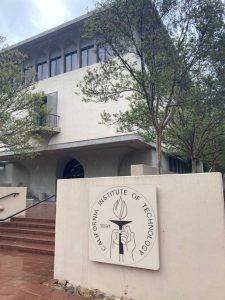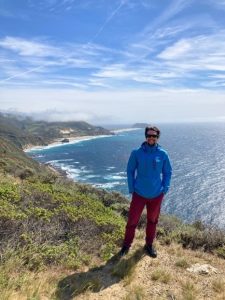 Jakob Dörr is a PhD student at the University of Bergen, working with Marius Årthun in the BCPU research area on “Understanding mechanisms for climate predictability”. In the spring of 2022, he travelled to California, to visit Dave Bonan. For four weeks, Jakob had the opportunity to work with Dave and his working group at the California Institute of Technology (Caltech) in Pasadena. Dave is also a PhD student, and also interested in understanding present and future changes in the Earth’s sea ice cover, and which processes these are caused by.
Jakob Dörr is a PhD student at the University of Bergen, working with Marius Årthun in the BCPU research area on “Understanding mechanisms for climate predictability”. In the spring of 2022, he travelled to California, to visit Dave Bonan. For four weeks, Jakob had the opportunity to work with Dave and his working group at the California Institute of Technology (Caltech) in Pasadena. Dave is also a PhD student, and also interested in understanding present and future changes in the Earth’s sea ice cover, and which processes these are caused by.
In the Arctic, the sea ice cover has strongly declined in all seasons over the last 40 years, and this is mostly due to the Earth’s warming, driven by anthropogenic greenhouse gas emissions. However, because the sea ice interacts with the ocean and the atmosphere and is thus part of the chaotic climate system, it is affected by random fluctuations and internal variability which is independent from the long-term warming trend. These variability modes can affect the sea ice for periods of up to several decades. It is therefore not entirely clear exactly how much of the sea ice loss we have observed over the last decades was due to global warming, and how much was because of internal variability. Dave and Jakob are working to detect and separate those variability modes that affect the sea ice over long periods (decades and longer) in the observational record of sea ice. They use a novel technique developed by Robb Wills at the University of Washington.
Jakob and Dave are hoping to determine for different regions of the Arctic, which modes of variability affect the sea ice cover, and how much their influence compares to the long-term sea ice loss due to global warming. This will help to understand and attribute past sea ice changes and enhance our ability to predict the future regional sea ice loss. While Jakob focuses on the Arctic, Dave applies the same technique to the Antarctic, where a steady increase in sea ice cover over the last decades, followed by a strong decline since 2016, has been observed. Their analysis might shed some light on the mechanisms behind this puzzling evolution, and how much of it was caused by changes due to global warming. The goal of the BCPU-supported visit was to prepare work for two separate publications on Arctic and Antarctic sea ice, respectively, and to discuss how experience from observations can be applied to analyse climate model simulations of future sea ice change.

“During the visit, we exchanged our experience and discussed new ideas for our analysis. I also got to meet scientists in both the Oceanography (Andrew Thompson) and the Climate Dynamics (Tapio Schneider) group at Caltech. I was also lucky to come at a time where Caltech was opening fully again, with many international scientists visiting the institute. Furthermore, I got invited to be part of a sea ice reading course where we had intense discussions about sea ice models, trends and mechanisms with Dave and other members of the Oceanography group. On top of that, I had the chance to visit some friends from the Scripps Institute of Oceanography in San Diego. I had a lot of interactions during the visit and learned a lot about how science is conducted at Caltech and other US institutions. I hope that I can continue the collaboration between Caltech and the Bjerknes Center beyond our work on sea ice observations. The visit showed me how important it is to physically meet people to exchange ideas and develop collaborations across the globe. There are plans that Dave visits us in Bergen next spring, and I hope to return to Pasadena after that.” – Jakob Dörr


